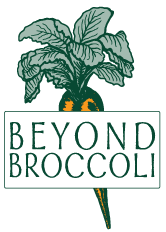Tired of the same old holiday nutrition tips that promote a focus on calories, fat grams, weight gain, and other negative consequences of dietary indiscretion, here are some ideas that fit more with the Beyond Broccoli nutrition philosophy and approach.
- Be kind to yourself. This does not replace the giving to others we emphasize during the holiday season – compassion for others is linked to self-compassion. You cannot give what you don’t have and you take the best care of what you love. You do the best you can and that is enough.
- Check in with why you are eating. The holiday season presents endless opportunities to graze mindlessly. Sometimes the simple question “what do I really need/want right now?” can stop or at least make you aware of eating for non-hunger reasons (emotions, environment, peer pressure).
- Eat slowly and intentionally. Identify pleasing flavors and textures in the food you eat and give your brain the 20 minutes it needs to identify fullness. It helps to eat sitting down with minimal distractions (not an easy task for many of us!).
- Notice how your body feels after you eat. This primitive instinct once let us know which foods (or amounts of food) caused digestive discomfort so we could avoid (or eat less of) the food the next time. Understanding which foods nourish our bodies best can empower us to make better choices.
- Eat regularly throughout the day. When we go too long without eating we set ourselves up to overeat. This is basic biology – part of our hard-wired survival instincts, now mismatched with our abundant food supply. If you are going to a holiday dinner or party in the evening you can make healthier food choices during the day, but skipping meals and arriving at your special occasion ravenous is not a good idea.
- Stay hydrated. Our need for fluid increases with many environmental extremes including hot, cold, dry and high altitude. Many of us are conscious about drinking more water when it’s hot but forget we need more when it’s cold and/or dry too. Soups and hot tea are great ways to increase fluid on cold days.
- Strive to include joyful movement in your busy holiday schedule. Physical activity can take many forms – find ways to move that you enjoy and you are more likely to keep this as part of your holiday self-care regimen. Forcing yourself to squeeze in a gym session can create more stress than it relieves. Dance at holiday parties, acknowledge that holiday shopping and cleaning are opportunities to be active and “count” as physical activity.
- Savor food you perceive as special treats. Choose your special treat foods, knowing that in our modern world most foods are available any time of year so identify the truly special foods for you. Notice that when you give yourself permission to eat and savor these foods you may “need” less of them to feel satisfied.
- Shared meals provide benefits beyond physical nourishment. Food connects us as humans – we all must eat to live. There is research that supports many benefits of family meals. Taking time to share meals during the holiday season can help us feel grounded, connected to each other, and in charge of our lives vs. stressed out about how out-of-control this season can get.
- Remember to breathe. Deep breathing has many benefits, especially related to stress resilience. Stress is an inevitable part of life and our ability to work through stressful moments or events is important for many reasons, including the ability to not use food as an antidote. Just 3 deep “belly breaths” can change the blood flow in your brain from your “fight or flight” response to your more “rational” thinking.



